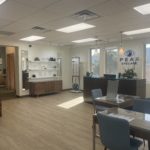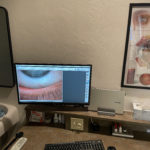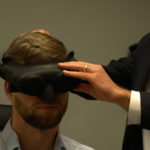
Dr. Capaccioli’s office with its open-floor plan creates a modern ambiance that goes well with the practice’s technology-forward brand.
By Davis Capaccioli, OD
May 25, 2022
Patients, like all consumers today, are becoming more sophisticated. They want the same level of service and ease in your office that they experience elsewhere. To meet my patient’s expectations, and deliver a high level of care, I made a few key practice investments.
I estimate that these investments will help me generate an additional $100,000, or more, annually in the years to come, which, in turn, will allow me to reinvest this profit into further improving the patient experience.
Here are the details on these modernizing investments I made in my office.
Remodeled to Create an Open-Floor Plan
I purchased my office building from an ophthalmologist in 2021. I initially wanted to keep my costs down, and, so, was not planning to remodel at all for a few years. However, after further consideration, I realized that I needed to create a better retail experience if I was going to be successful selling high-quality frames.
I decided the remodel, along with other improvements like better lighting, were worth the gamble of a higher upfront cost for a better patient perception of our practice and better retail experience. It also would enable patients to better appreciate the gorgeous view of the Rocky Mountains which we have from our office.
The remodel took just one month and cost us $50,000. I delayed my opening by a month so I could complete this project.
Patients often compliment us on how open the office feels, and they love the views. It gives the office a modern feeling that goes well with our technology-forward practice brand.
I have already surpassed my expectations in glasses sales, and noticed many positive online reviews on my optical alone.

Flat screen monitors like this, on wall-mount swivel arms, make it easier for patients to see and understand their diagnoses and treatment plans. Compliance with the care regimen prescribed then becomes more likely.
Flat-Screen Monitors in Exam Rooms with Swivel Wall Mounts
Flat-screen monitors, which we use to show patients the condition of their eyes and help them better understand diagnoses and treatment plans, were an addition to our office that modernized us even further. Exam rooms look more modern with flat screens, and patients appreciate the greater education we can provide about their eyes.
It cost us $600 in total to add these flat-screen monitors to our exam rooms.
Patients love seeing their retinal photos blown up, or being able to see telangiectasia on their lid margins. The swivel wall mount allows me to better face the patient when typing, and better show the patient the screen when necessary.
From a dry eye standpoint, when patients can actually see the signs of inflammation on their lid margin, see the blepharitis on their lashes, or see the small retinal hemorrhage, they are much more likely to purchase warm compress masks or lid scrubs in our office, and start the treatment immediately, than if I just told them “you have blepharitis, you should buy this.” Their understanding of their condition, and thus, their ability to take ownership of their treatment plan, is vastly improved.
Adding this feature to our exam rooms was as easy as going to Best Buy and buying a CPU monitor (I made the mistake of buying an HD 1080 TV initially, but the resolution is much better on an actual CPU monitor; mine is made by Acer). I also bought a wall swivel mount from Best Buy, along with an HDMI cable.

Dr. Capaccioli positions Heru on a patient for a visual field test. This technology has changed how he screens for vision disorders.
Wearable Diagnostic Technology
At a time when patients are used to wearable technology, diagnostic technology that can also be wearable seemed like a smart, modernizing addition to my practice. For that reason, I added Heru , which enables me to more easily and effectively conduct visual field (VF) testing.
VF testing plays an essential role in the diagnosis and management of eye conditions including glaucoma. Your patients in need of perimetry may have physical limitations that make the traditional way of performing this exam difficult.
Heru leverages commercially available AR/VR head-mounted displays. The Heru platform performs six vision diagnostic exams, including suprathreshold and full threshold visual fields. This technology has provided my practice an advantage and the flexibility I need to effectively diagnose and manage progressive eye conditions like glaucoma.
Other Articles to Explore
The Heru platform is much more comfortable for the patient to use than legacy technology, which requires them to keep their head leaning forward in an awkward position. This can be especially challenging for elderly patients or those with mobility issues.
Patients can sit comfortably anywhere in my office during their exam when getting VF testing done. It is easy for them to put on the headset, but a doctor or technician needs to help position it. My patients rave about how much more they enjoy a visual field with the Heru device than with legacy technology. Patients dread VT testing, but now with this technology, they view it as an enjoyable, interactive, new experience. They are thrilled to learn that they will not have to put their head in a “big white bowl.”
I am trying to keep my overhead low, but will add color vision screening, contrast sensitivity testing and dark adaptation testing via Heru as my patient base grows. Having one device that I can use for multiple billable exams is very exciting–and profitable.
Click HERE to read more about Dr. Capaccioli’s decision to implement wearable diagnostic technology in his practice.
 |
Davis Capaccioli, OD, is the owner of Peak Eyecare in Durango, Colo. To contact him: drcap@peakdurango.com |





















